There’s no such thing as too much pasta. One of Italy’s greatest gifts to the Earth should be enjoyed thoroughly and often. Before you get started, make sure you’ve got some quality olive oil on hand and plenty of fresh herbs to throw in the mix. Also, be sure to treat yourself to some high-end pasta (or, make pasta yourself if you have the time and skills).
Admittedly, the following five classic Italian pasta recipes are ambitious, with some dishes requiring multiple steps. But the payoff of this culinary adventure will be well worth the effort.
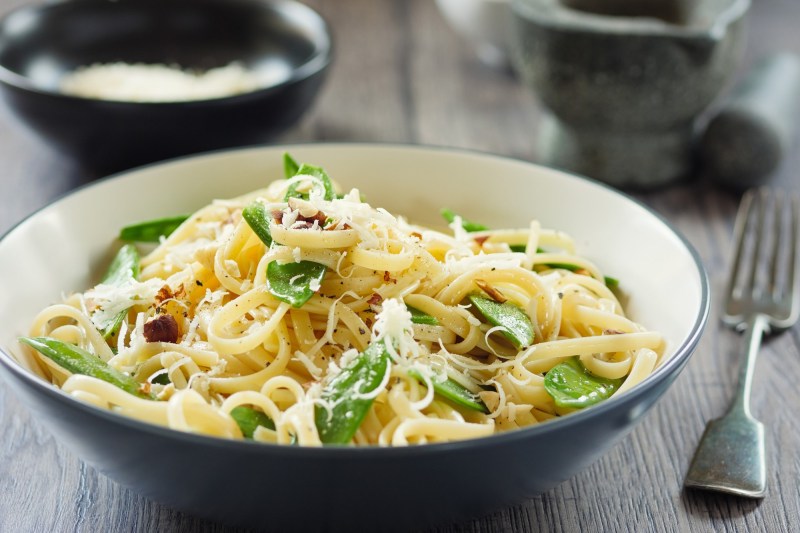
Bucatini all’Amatriciana Recipe
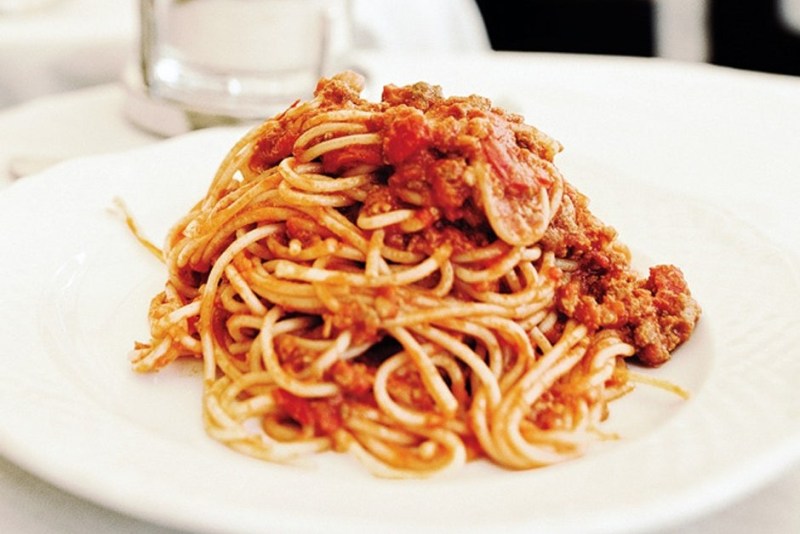
(Courtesy of Sarah Tenaglia and Selma Brown Morrow at Bon Appétit)
Bucatini might just be our favorite pasta type ever. It’s like a more elevated version of spaghetti, with more texture and the ability to take on more sauce.
Prep Time: 15 minutes
Total Time: 45 minutes
Yield: 2-3
Ingredients:
- 2 tbsp extra-virgin olive oil
- 4 ounces sliced guanciale, pancetta, or chopped unsmoked bacon
- .5 teaspoon crushed red pepper flakes
- .5 teaspoon freshly ground black pepper
- .75 cup minced onion
- 2 cloves garlic, minced
- 1 28-ounce can peeled tomatoes with juices, crushed by hand
- Kosher salt
- 12 ounces dried bucatini or spaghetti
- .25 cup finely grated Pecorino (about 1 ounce)
Method:
- Heat oil in a Dutch oven or large heavy skillet over medium heat. Add guanciale and sauté until crisp and golden, about 4 minutes. Add pepper flakes and black pepper; stir for 10 seconds. Add onion and garlic; cook, stirring often, until soft, about 8 minutes. Add tomatoes, reduce heat to low, and cook, stirring occasionally, until sauce thickens, 15-20 minutes.
- Meanwhile, bring a large pot of water to a boil. Season with salt; add the pasta and cook, stirring occasionally, until 2 minutes before al dente. Drain, reserving 1 cup of pasta cooking water.
- Add drained pasta to sauce in skillet and toss vigorously with tongs to coat. Add 1/2 cup of the reserved pasta water and cook until sauce coats pasta and pasta is al dente, about 2 minutes. (Add a little pasta water if sauce is too dry.) Stir in cheese and transfer pasta to warmed bowls.
Lasagna Recipe
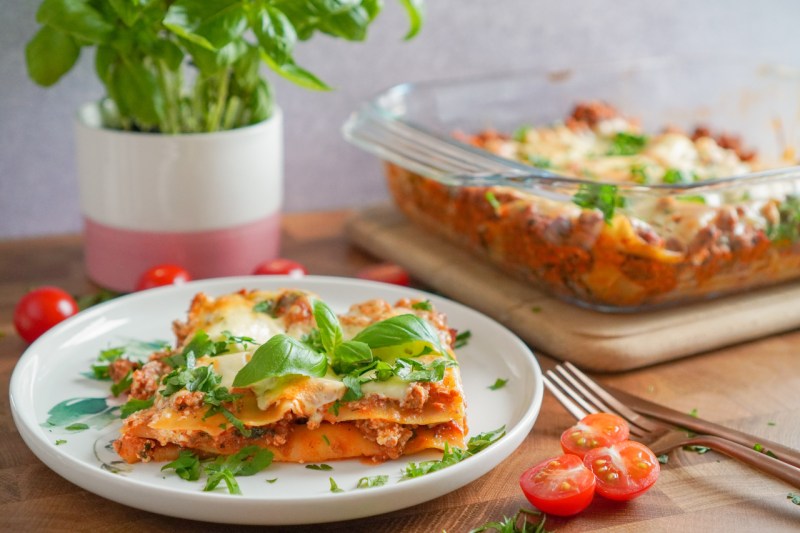
(Courtesy of Jamie Oliver)
Jamie Oliver has a knack for Italian cuisine and this recipe is proof of that skill. Make a big old batch and enjoy it all week, the leftovers are just as good (if not better).
Prep Time: 15 minutes
Total Time: 3 1/2 hours
Yield: 3-4
Ingredients:
For Red Sauce:
- 2 sprigs of fresh rosemary
- 3.5 ounces higher-welfare smoked streaky bacon
- Olive oil
- 2 pounds quality minced beef
- 2 pounds minced pork
- 4 carrots
- 2 onions
- 4 sticks of celery
- 2 tbsp tomato purée
- 4 x 15-ounce cans of plum tomatoes
- 1.5 cups dried lasagna sheets
For White Sauce:
- 5 ounces mature cheddar cheese
- 2 medium leeks
- 2 fresh bay leaves
- 4 tbsp plain flour
- 4.25 cups semi-skimmed milk
- 1 whole nutmeg, for grating
Method:
- Strip and finely chop the rosemary leaves and finely chop the bacon.
- Heat 1 tablespoon of oil in a large casserole pan on high heat. Once hot, add the rosemary and bacon and fry for 2 minutes, or until the bacon starts to crisp up, stirring regularly.
- Add all the minced meat, using a wooden spoon to break it up as you go. Reduce the heat to medium and cook for at least 10 minutes, or until all the liquid has evaporated, stirring occasionally.
- Place the coarse grater attachment in your food processor (or you could use a box grater instead) and grate the cheddar, then tip into a bowl.
- Replace the grater with the regular blade. Trim and halve the carrots, then add to the processor and blitz to roughly the same size as the mince. Peel and halve the onions, add them to the carrot, and blitz again.
- Tip into the pan with the mince while you get on with blitzing and adding the celery. Cook for 15 to 20 minutes, or until the vegetables start to soften, stirring regularly.
- Next, add the tomato purée and plum tomatoes, breaking them up with a spoon. Fill each of the tins with water and tip into the pan.
Give everything a good stir and reduce the heat to low. Leave to simmer around 2 hours, or until thickened and reduced, stirring occasionally. - While that ticks away, make your white sauce. Trim, wash, and finely slice the leeks, then add to a pan along with 2 tablespoons of oil and the bay leaves. Stir well and season with a tiny pinch of sea salt and black pepper.
- Reduce the heat to low and cook for 30 minutes, or until sweet and softened, adding splashes of water, if needed.
- Add the flour and stir well to coat, then gradually add the milk, stirring continuously. Turn the heat up to medium, bring to a boil, then reduce to low and cook for 5 to 10 minutes, or until thickened, stirring regularly.
- Carefully transfer the sauce to the food processor and blitz until smooth and silky. Add half the grated cheese and finely grate over half the nutmeg and mix well. Season to taste.
- Once the ragù is ready, preheat the oven to 375 degrees Fahrenheit.
- Season the ragù to taste, then transfer half into freezer bags, portioning up as appropriate for your family. Allow to cool to room temperature, then pop in the freezer for another day. It’s a good idea to freeze them flat so that you can reheat them quickly and easily. It’s also a good idea to label and date them to avoid a game of freezer roulette in a few weeks’ time!
- To build your lasagna, spoon a quarter of the ragù into a large deep ovenproof dish and spread it out evenly.
- Spoon over a quarter of the white sauce, then snap over some lasagna sheets, making sure they completely cover the sauce in one layer. Repeat this 3 times, finishing with a layer of white sauce.
- Sprinkle the remaining cheese and bake the lasagna in the oven for 45 minutes or until golden and bubbling.
- Remove the lasagna from the oven and leave to sit for 5 to 10 minutes before serving.
Baked Ziti Recipe
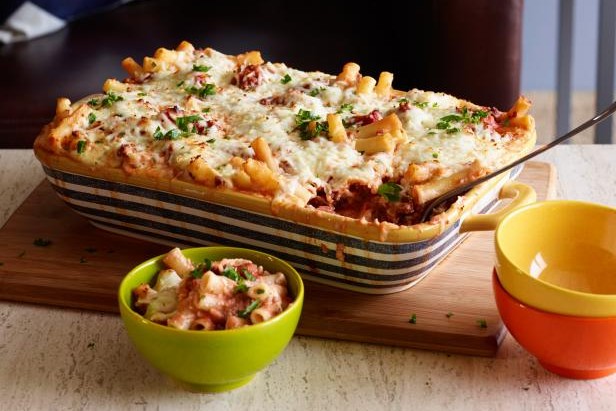
(Courtesy of Ree Drumond at Food Network)
You need this Neapolitan classic on your shortlist of splendid pasta. It’s a tomato-based pasta casserole dish that’ll carry you through winter, Italian-American style.
Prep Time: 10 minutes
Total Time: 1 1/2 hours
Yield: 3-4
Ingredients:
Method:
- Heat the olive oil in a pot over medium heat. Add the garlic and onions and sauté until starting to soften, 3 to 4 minutes. Add the ground beef and sausage and cook until browned. Drain off almost all of the fat, leaving a bit behind for flavor and moisture. Add the tomato sauce, tomatoes, Italian seasoning, red pepper flakes and some salt and pepper. Stir and simmer for 25 to 30 minutes. Remove 3 to 4 cups of the cooked sauce to a bowl to cool down.
- Bring a large pot of water to a boil and add some salt. Cook the ziti until not quite al dente.
- Preheat the oven to 375 degrees F.
- In a bowl, mix 2 cups of the grated mozzarella, ricotta, Parmesan, parsley, eggs, and some salt and pepper. Stir together just a couple of times (do not mix completely).
- Drain the pasta and rinse under cool water to stop the cooking and cool it down. Pour it into the bowl with the cheese mixture and toss to slightly combine (there should still be large lumps). Add the cooled reserved meat sauce and toss to combine.
- Add half the coated pasta to a large casserole dish or lasagna dish. Spoon half of the remaining sauce over the top, then top with half the remaining mozzarella. Repeat with another layer of the coated pasta and the remaining sauce and mozzarella.
- Bake until bubbling, about 20 minutes. Let stand 5 minutes before sprinkling with chopped parsley to serve.
Basil Pesto Recipe
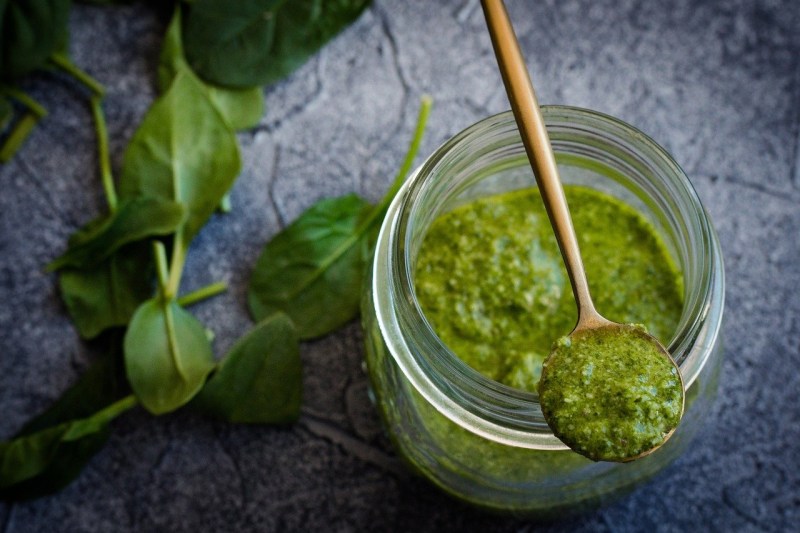
(Courtesy of The Food Network Kitchen)
While the red sauce is a classic, sometimes you need a good green base for your favorite pasta. Whether it’s angel hair, orecchiette, or penne, this trusty pesto sauce will be equally delicious on all of them.
Prep Time: 5 minutes
Total Time: 5 minutes
Yield: 1 cup
Ingredients:
- 2 cups packed fresh basil leaves
- 2 cloves garlic
- .25 cup pine nuts
- 2/3 cup extra-virgin olive oil, divided
- Kosher salt and freshly ground black pepper, to taste
- .5 cup freshly grated Pecorino cheese
Method:
- Combine the basil, garlic, and pine nuts in a food processor and pulse until coarsely chopped. Add 1/2 cup of the oil and process until fully incorporated and smooth. Season with salt and pepper.
- If using immediately, add all the remaining oil and pulse until smooth. Transfer the pesto to a large serving bowl and mix in the cheese.
- If freezing, transfer to an air-tight container and drizzle remaining oil over the top. Freeze for up to 3 months. Thaw and stir in cheese.
Cacio e Pepe Recipe

Total Time: 20 minutes
Yield: 1-2
Ingredients:
- 6 ounces pasta (such as egg tagliolini, bucatini, or spaghetti)
- 3 tbsp unsalted butter, cubed, divided
- 1 tsp freshly cracked black pepper
- .75 cup finely grated Grana Padano or Parmesan
- 1/3 cup finely grated Pecorino
- Kosher salt
Method:
- Bring 3 quarts water to a boil in a 5-quart. pot. Season with salt; add pasta and cook, stirring occasionally, until about 2 minutes before tender. Drain, reserving 3/4 cup pasta cooking water.
- Meanwhile, melt 2 tablespoons of butter in a Dutch oven or other large pot or skillet over medium heat. Add pepper and cook, swirling pan, until toasted, about 1 minute.
- Add 1/2 cup reserved pasta water to skillet and bring to a simmer. Add pasta and remaining butter. Reduce heat to low and add Grana Padano, stirring and tossing with tongs until melted. Remove pan from heat; add Pecorino, stirring and tossing until cheese melts, sauce coats the pasta, and pasta is al dente. (Add more pasta water if sauce seems dry.) Transfer pasta to warm bowls and serve.
Editors' Recommendations
- 5 deliciously easy no-bake dessert recipes
- A novice cheesemaker’s guide on how to make cheese at home
- 22 easy cocktail recipes you can make at home
- The amazing 3-ingredient cocktails every home bartender should know
- The 5 classic whiskey cocktails you need in your bartending repertoire




